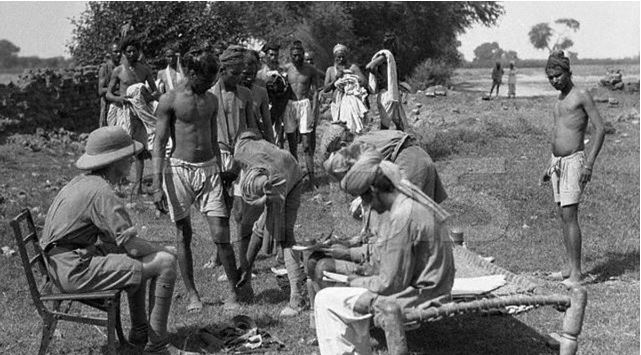100th anniversary of Guru Ka Bagh Morcha: When British atrocities in Amritsar caught international media’s eye
British govt took refuge in architect Sir Ganga Ram to defuse crisis
To keep the protesters’ spirit high, Guru Ka Bagh Morcha was regularly invoked during the almost one-year-long farmers’ agitation against the now-repealed three farm laws in Delhi.
Guru Ka Bagh is a historical Sikh Gurudwara related to Guru Ka Bagh Morcha related to Guru Arjun Dev ji and Guru Teg Bhadur Ji at Ghukewali village, around 25 km from Amritsar.
More than three months’ long agitation as part of Gurudwara Reform Movement of Guru Ka Bagh Morcha registered arrests of 5,605 Sikhs, left 1,500 injured and 12 martyrs between August 8 and November 17, 1922.
A three-day congregation organised by Shiromani Gurdwara Parbandhak Committee (SGPC) to mark the centenary event of the Morcha (agitation) started at Gurudwara Guru Ka Bagh on Saturday.
It was a rare agitation in which the British atrocities on peaceful protesters were recorded on still and video cameras.
English missionary and educationist C F Andrews (1871-1940), who saw Gurudwara Guru Ka Bagh, put it, “Hundreds of Christs being crucified.”

He wrote, “There were four Akali Sikhs with black turbans facing a band of about a dozen policemen, including two English officers. They were perfectly still and did not move forward. Their hands were placed together in prayer and it was clear that they were praying. Then, without the slightest provocation on their part, an Englishman lunged forward the head of his lathi which was bound with brass. He lunged it forward in such a way that his fist which held the staff struck the Akali Sikh, who was praying, just at the collar bone with great force… When one of the Akali Sikhs had been hurled to the ground and was lying prostrate, a police sepoy stamped with his foot upon him, using his full weight; the foot struck the man between the neck and the shoulder. The vow they had made to God was kept. I saw no act, no look, of defiance. It was true martyrdom for them as they went forward, a true act of faith, a true deed of devotion to God.”
Why agitation started
Gurudwara Guru Ka Bagh was not in direct control of SGPC. Administration of Gurudwara was in the hands of Mahant Sundar Das. He considered Gurudwara and its 524 kanals of land as his personal property. He had the support of the British government.
It was on August 8, 1922, that five Sikhs axed wood from the trees on the land of Gurudwara Guru Ka Bagh for using the same in community kitchen. The British government arrested the Sikhs for allegedly stealing wood from the land as Mahant Sundar Das claimed he was the legal cultivator.
The arrest of Sikhs launched a fresh agitation as part of Gurudwara Reform Movement. The SGPC started sending Sikhs daily for making their arrests at Guru Ka Bagh Morcha. Police started formally arresting the protesters on August 22, 1922. Four Sikhs were arrested on August 23 and later they were sentenced to one-year imprisonment along with a fine of Rs 300 each. Total 180 Sikhs were arrested till August 24.
The atrocities on peaceful protesters started on August 25, 1922. The SGPC set up a temporary hospital for the injured near the Guru Ka Bagh Morcha sight.
The daily number of arrests increased to 100. The stories of atrocities on protesters spread around the country. It caught the attention of national and international media. They covered the peaceful agitation, atrocities and caught everything on camera. All India Congress Working Committee also prepared a note on the agitation.
Protesters were sent to different jails across the country. Sikhs would offer langar to prisoners at railway stations. On October 29, 1922, station master of Hasan Abdal railway station declined to stop train which was carrying 400 Sikh prisoners from Guru Ka Bagh Morcha to Attock. Sikhs decided to sit on rail tracks on which the train was coming with Sikh prisoners. Two Sikhs were killed on the tracks while trying to stop the train. The train was stopped and langar was offered. This became another big chapter in Sikh history as Saka Panja Sahib.
The British government sensed the anger among the Sikh. But it was not ready to give up. So the British government involved the great architect, Sir Ganga Ram. The British made Mahant Sunder Das sell the land to Sir Ganga Ram.
Sir Ganga Ram told the British police to leave the land of Gurudwara Guru Ka Bagh after he owned it. Later Sir Ganga Ram went to Akal Takht and handed over the land ownership papers to the SGPC.
The British committed atrocities against many Sikhs in jail. Some of them could not even walk when they came out of jail.
Babar Akalis avenged atrocities against protesters
Though Guru Ka Bagh was a non-violent protest, hardliner Babar Akalis had avenged the atrocities committed against the Sikh protesters by killing S G M Beatty, who was the Additional SP, Amritsar. Sikhs believed that he played a key role in the acts of extreme cruelty against Sikh protesters.


